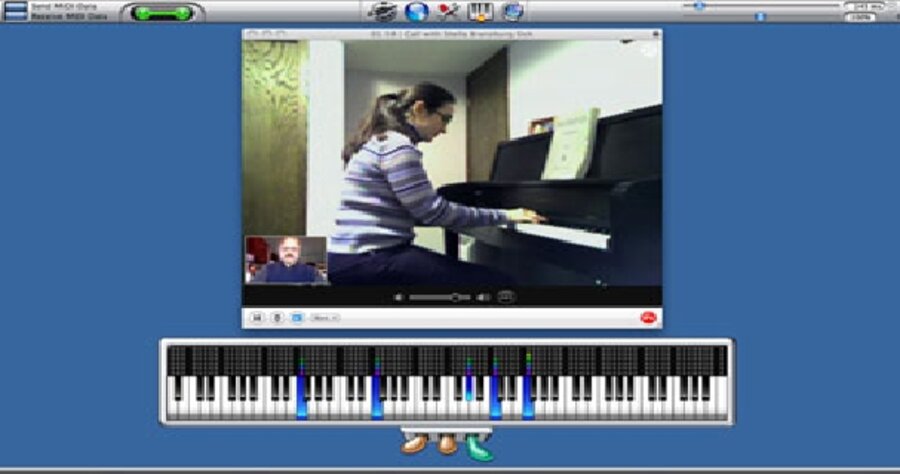The worldwide jam session
Loading...
Every week, Kristin Shoemaker boots up her computer and webcam and plugs in her Yamaha keyboard. More than 8,000 miles away in Macha, a tiny, remote village in Southern Zambia, 8-year-old Merel van Stam sits in front of her computer and Yamaha keyboard and waits for her music teacher’s instructions.
Soon, from her home in Lakeville, Minn., Ms. Shoemaker will teach Merel how to play basic piano chords and scales.
“For us to link up our two keyboards – here she is halfway around the world – I can hear her like she’s in my living room,” Shoemaker says in a phone interview.
Thanks to advances in technology, musicians and music educators are finding new ways to collaborate. Teachers are using video services such as YouTube and Ustream to upload daily lessons. Webcams enable students and teachers to see one another face-to-face via Skype, an Internet phone and video service.
They also can play piano together over the Web using special software programs, such as TimeWarp Technologies’s Internet MIDI Software.
“I believe this is going to make it possible to develop musical communities of students and teachers who otherwise would’ve had a hard time ... getting together,” says George Litterst, president of TimeWarp Technologies, in Rehoboth, Mass.
Gay Garard-Brewer never imagined she would continue to teach her piano students after moving from California to Seeley Lake, Mont. But after installing the TimeWarp software and a DSL connection two months ago, she started to teach them over the Internet. Recently, she and Mr. Litterst even played piano with her students and watched from afar during a piano recital in California.
One advantage of teaching remotely, she says, is having greater availability for lesson times, but a disadvantage is not “being able to reach over and take a kid’s hand ... and [move] it to the correct spot.”
Another obstacle when teaching remotely, Shoemaker says, is the occasional loss of video and audio capabilities through Skype due to poor Internet connections.
Virtual lessons may never replace the real thing, says Chad Criswell, a music instructor who has been following technology trends in music education for the Iowa Music Educator’s Association. But, he says, it may set a precedent of what’s to come.
“I don’t think it’s going to replace the flesh-and-blood music teacher needing to be in the room, but I do think it’s going to be something that can supplement and save people money, especially school districts,” Mr. Criswell says. “It’s not being used very widely, but it’s starting to move along in ways that I think in the next 10 to 15 years will be quite commonplace.”
Music teachers aren’t the only ones using the Internet to collaborate. Professionals, even amateurs, have logged on to social-networking sites such as Indaba Music to record with musicians from the comfort of their home computers.
Users can sign up for an Indaba Music account free of charge. After that, they can use the site’s audio-editing tools or browse listings of some 100,000 musicians in more than 175 countries.
“Really, people use Indaba in so many different ways,” says Matt Siegel, cofounder and co-CEO of Indaba Music in New York.
Within a few minutes, musicians can use the website to post a guitar lick or drum beat to their profile. Later, they may find that a musician from Africa or Europe has added his or her own lyrics or bass line to the mix.
That’s what happened to Joe Speranzella, a Web designer in Chinoteague Island, Va. After posting some musical ideas on Indaba Music, he noticed that another user from Germany had added to the song.
Mr. Speranzella says he logs onto Indaba Music once a day, sometimes for two to three hours at a time, to collaborate with other musicians from around the world. For Speranzella, who spent his teenage years playing in bands, Indaba Music provides a creative outlet.
“Now I’m a family man. I’ve got a wife and children and responsibilities. Still, I have this creative urge to try new things and be out there inventing,” he says.
Advances in software have also made it possible for musicians to record and play music together in real time over the Internet. Musicians can hold virtual jam sessions with eJamming AUDiiO. The software allows up to four people at a time to play together. Users also can audition before entering a session.
One of the longest distance sessions consisted of musicians from Japan, Copenhagen, and San Francisco, according to Alan Jay Glueckman, president and chairman of eJamming AUDiiO.
The software has 18,000 beta testers and their international reach spans 158 countries – opening up the possibilities to instantly record the sounds from around the globe.
“If you want a musician that can really play a Latin beat go to Latin America and get one. And African rhythm: Get their beat and record their playing,” Mr. Glueckman says. “We’re going to ring the whole world of musicians together.”
While something may be lost by jamming via computer rather than with other musicians in a garage or a basement, there are plenty of opportunities to find new bandmates.
“We certainly believe that no technology is going to replace the way that people have played music since the beginning of time. There’s always going to be a chemistry and excitement of people sitting in the same room together,” says Mr. Siegel of Indaba Music. Now “there are more opportunities.... It means that people will be able to play music with many, many more people than were available to them in the past.”





